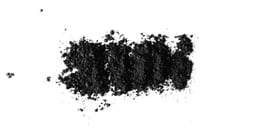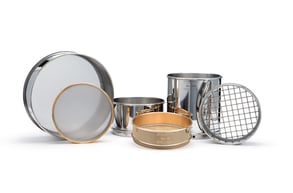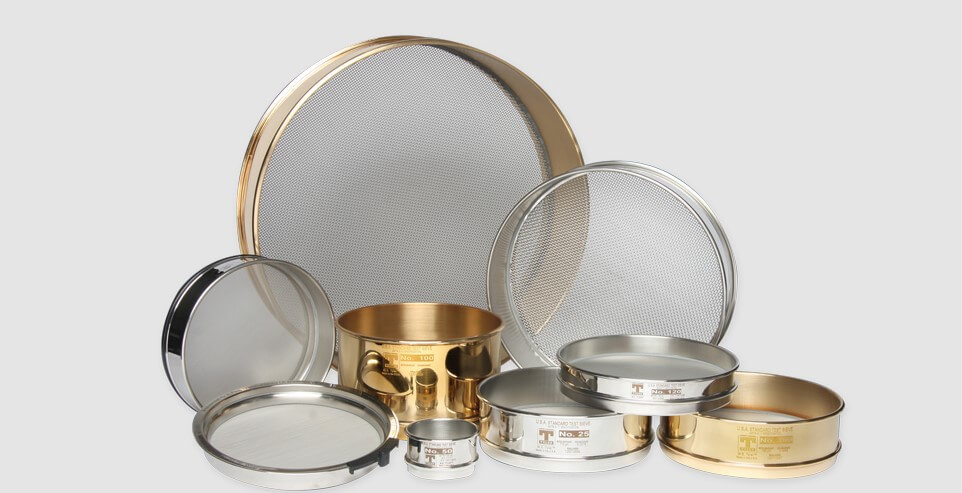How Sieve Size and Sample Weight Affect Particle Size Analysis
Particle analysis is a fundamental element to the quality control of any production line. In order to yield accurate and repeatable results, you must be aware of the sieve size and sample weight that is best for your particle analysis process.
But how exactly do sieve size and sample weight complement each other during particle analysis?
W.S. Tyler has been a pioneer of test sieve analysis since the 1930s and has developed the expertise needed to help its customers achieve optimal particle analysis results.
With that, this article will define sample weight, sieve size, explain how each element benefits particle analysis individually, and explain how they both work together to produce reliable results.
What Is Sample Weight?
Before you begin any particle analysis process, you must first divide a batch of sample material into smaller representative samples that are easy to manage. The term sample weight refers to the weight of your initial representative sample(s).
So why is it so important?
Well, when you conduct a particle analysis, the sample weight is compared to the variating weights of sample material retained on each sieve to calculate the distribution of the material. If you are unaware of the initial weight of your representative sample(s), there is no way to accurately orchestrate the math needed to yield a reliable distribution curve.
This ideology applies to the physical test sieves used in sieve shakers and air jet sieves as well as the virtual sieves used during a dynamic image analysis.
The sample weight will also help to ensure that your representative sample is an appropriate size for your test sieves.
Testing too large of a sample can cause blinding in physical test sieves, preventing the particles from passing through the sieve stack. On the other hand, testing a sample that is too small may yield false results.
How Do I Accurately Calculate the Weight of My Sample?
Once you have divided your representative samples, the easiest way to begin the weighing process is to pick a round number that complies with the weight listed in your industry standards.
You then place a collection pan on a scale that goes to at least the tenth decimal point and pour your sample into the collection pan. It should be noted that most operations throughout the world use grams as the measurement unit to represent their sample material.
Now, when weighing your sample material, it is important that you take the weight of the collection pan into consideration. A lot of the time, operators neglect to subtract the weight of the collection pan and use a false sample weight.
To remedy this issue, you can tare the scale after placing the collection pan on the scale but before pouring the sample into the pan. Taring your scale with the collection pan on it accurately zeros out the weight of the pan, eliminating the need for additional math.
With that, if you forget to tare your scale, you can simply subtract the weight of the collection pan from your final sample weight.
What Is Sieve Size?
The term sieve size can be used to describe two aspects of a test sieve: the diameter of the sieve frame as well as the mesh count of the sieve. For the purpose of this article; however, we are referring to the diameter of a test sieve.
Typically, sieves have either a 12”, 8”, 3”, 300mm, and 200mm diameter. Selecting the right diameter is crucial for any test sieve analysis.
When you’re conducting a test sieve analysis, you want to make sure that the sample material does not cover more than half the surface area of the mesh screen. If the sample material covers more than half the screen, the particles won’t have enough room to find the openings and will eventually clog the mesh.
How Do I Select the Right Sieve Size?
Selecting the right sieve size for your operation ultimately comes down to the size of the particles in which you are analyzing.
To explain this in more detail, let’s say you are working with particles that are no bigger than 1”. In most cases, sieves with a diameter up to 8” would be able to efficiently sieve the material.
If this is what your operation typically looks like, you should refer to your industry standards to identity which sieves, within that allotted diameter range, work best.
However, if you are working with particles that exceed 1” on a regular basis, a 12” sieve may be right for you, as they are a little deeper and provide more room for those larger particles to move.
How Does Sample Weight and Sieve Size Complement Each Other?
To put this all into perspective, obtaining the weight of your representative sample(s) is the starting point of any test sieve analysis and dictates the accuracy of your final particle analysis results.
After the sample weight is recorded, you must run the sample through a sieve stack to generate a reliable distribution curve. This is where having the correct sieve size is everything.
The sieve size you choose will dictate the particles’ ability to find the openings in the sieve mesh properly. When it comes time to weigh the sample material retained on each sieve, each fraction of material should ultimately add back up to the original sample weight and provide a true overview of your production line.
What Should I Do If I'm Having Trouble Selecting the Right Sieve Size or Sample Weight?
Determining the right sieve size or sample weight for your operation can sometimes be difficult. Should you have any questions when trying to determine the right sample weight and sieve size for your operation, you can:
- Refer to your industry standards for guidance
- Conduct trial tests using different sample sizes until optimal, repeatable results are achieved
- Reach out to our team of experts who will gladly talk you through whatever questions you may have
How to Contact Us:
- Go to our Contact Us page and fill out the form
- Email your configuration and contact information to our sales team at info@wstyler.com
- Reach out to us via phone at 800-321-6188
- Provide our interactive chat bot (lower right-hand corner of this page) with your
credentials and specific configuration needs
Become a Particle Analysis Expert With Us
When it comes to the quality control of most production lines, particle analysis is key. In order to ensure you yield accurate results, you must use a sieve size and sample weight that complies with the standards of the industry in which you work.
Sample weight is used to define the weight of the representative sample(s) that you will be testing. Knowing the right sample weight allows you to coordinate the math needed to generate a distribution curve that represents the material that will be used in the final product.
Sieve size refers to the diameter of the sieve frame which also translates to the surface area of the mesh. It’s vital that the correct sieve size is used as it can dictate the particles’ ability to make their way through the sieve stack.
When paired correctly, the sample weight and sieve size work together to provide an accurate overview of your production line.
Having worked in the particle analysis industry for over 140 years, W.S. Tyler is here to provide you with the knowledge needed to ensure your particle analysis process produces desirable results.
To learn more about which sieve size may be right for you, refer to our Test Sieves, Sieve Shakers & Particle Analysis Equipment Product Guide.
Want all the latest industry trends and innovations sent directly to your inbox? Subscribe to our monthly newsletters today.
About Ronnie Brown
Ronnie is the Content Writer for W.S. Tyler and has four years of experience as a professional writer. He strives to expand his knowledge on all things particle analysis and woven wire mesh to leverage his exceptional writing and graphic design skills, creating a one-of-a-kind experience for customers.





